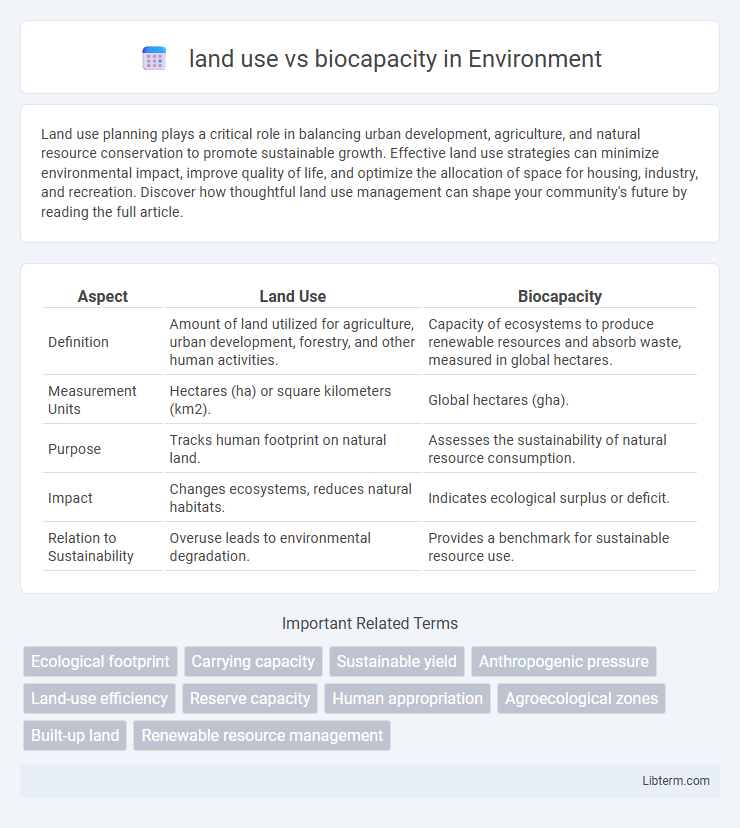Land use planning plays a critical role in balancing urban development, agriculture, and natural resource conservation to promote sustainable growth. Effective land use strategies can minimize environmental impact, improve quality of life, and optimize the allocation of space for housing, industry, and recreation. Discover how thoughtful land use management can shape your community's future by reading the full article.
Table of Comparison
| Aspect | Land Use | Biocapacity |
|---|---|---|
| Definition | Amount of land utilized for agriculture, urban development, forestry, and other human activities. | Capacity of ecosystems to produce renewable resources and absorb waste, measured in global hectares. |
| Measurement Units | Hectares (ha) or square kilometers (km2). | Global hectares (gha). |
| Purpose | Tracks human footprint on natural land. | Assesses the sustainability of natural resource consumption. |
| Impact | Changes ecosystems, reduces natural habitats. | Indicates ecological surplus or deficit. |
| Relation to Sustainability | Overuse leads to environmental degradation. | Provides a benchmark for sustainable resource use. |
Understanding Land Use and Biocapacity
Land use directly impacts biocapacity by determining the extent and health of ecosystems capable of producing renewable resources and absorbing waste. Biocapacity measures the productivity of ecological assets such as cropland, forests, and fishing grounds relative to human demand for these resources. Sustainable land use practices are essential to maintaining or enhancing biocapacity, ensuring that resource consumption does not exceed the environment's ability to regenerate.
Key Differences Between Land Use and Biocapacity
Land use refers to the human management and modification of Earth's surface for purposes such as agriculture, urban development, and forestry, whereas biocapacity measures the capacity of an area's ecosystems to produce renewable resources and absorb wastes. The key difference lies in land use representing demand or pressure on natural resources, while biocapacity represents the supply or ecological productivity available. Understanding the balance between land use intensity and biocapacity is essential for sustainable development and preventing ecological overshoot.
Measuring Biocapacity: Indicators and Methods
Measuring biocapacity involves quantifying the productive area of ecosystems available to generate renewable resources and absorb wastes, primarily expressed in global hectares (gha) per capita. Key indicators include ecological footprint analysis, which compares human demand on nature against the land's capacity to regenerate, and satellite remote sensing data to assess land cover and biomass productivity. Methods integrate geographic information systems (GIS), land-use classification, and yield factors to estimate biocapacity across croplands, forests, grazing areas, and fishing grounds.
Land Use Patterns and Their Environmental Impact
Land use patterns significantly affect biocapacity by altering ecosystems and resource availability, with urban expansion, deforestation, and agriculture reshaping natural habitats. Intensive agriculture and infrastructure development reduce biodiversity and soil quality, diminishing the land's capacity to regenerate resources and absorb carbon dioxide. Sustainable land management practices enhance biocapacity by promoting ecosystem resilience, balancing human needs with environmental conservation.
Human Activities Affecting Biocapacity
Human activities such as deforestation, urbanization, and intensive agriculture significantly reduce biocapacity by degrading natural ecosystems and diminishing biodiversity. Overextraction of resources and land conversion for industrial purposes accelerate soil erosion and habitat loss, impairing the land's ability to regenerate. Sustainable land management practices are essential to maintain biocapacity and reduce the ecological footprint caused by expanding human land use.
Urbanization: Strain on Biocapacity
Rapid urbanization intensifies land use by converting natural habitats and agricultural areas into built environments, significantly reducing biocapacity. This expansion leads to increased resource consumption and waste generation, surpassing local ecosystems' ability to regenerate. Effective urban planning must balance growth with ecological limits to sustain biocapacity and prevent environmental degradation.
Agriculture’s Role in Land Use and Biocapacity
Agriculture occupies approximately 37% of the Earth's terrestrial surface, significantly influencing global land use patterns and biocapacity. Intensive farming practices can deplete soil nutrients and reduce ecosystem resilience, thereby lowering the land's biocapacity to regenerate natural resources. Sustainable agricultural methods, such as crop rotation and agroforestry, enhance soil health and increase biocapacity, supporting long-term food security and ecological balance.
Deforestation and Its Biocapacity Implications
Deforestation significantly reduces global biocapacity by depleting forests that act as carbon sinks and support biodiversity, leading to diminished ecosystem services. Land use changes, primarily for agriculture and urban development, accelerate forest loss, disrupting natural carbon sequestration and lowering the earth's capacity to absorb CO2 emissions. The resulting imbalance between land use and biocapacity intensifies carbon footprints and undermines sustainable resource management efforts worldwide.
Strategies to Balance Land Use and Biocapacity
Implementing sustainable agriculture practices, such as agroforestry and crop rotation, enhances land productivity while preserving soil health and biodiversity. Urban planning that incorporates green spaces and vertical expansion reduces land consumption and maintains ecological functions. Restoring degraded lands and protecting natural habitats increase biocapacity, enabling ecosystems to support greater biological demands sustainably.
Sustainable Development: Moving Toward Harmony
Balancing land use with biocapacity is critical for sustainable development, ensuring that natural resources are not depleted faster than they regenerate. Efficient land management practices, such as agroforestry and urban green spaces, enhance ecosystem services while supporting human needs. Aligning development goals with ecological limits promotes harmony between economic growth and environmental stewardship, fostering long-term resilience.
land use Infographic

 libterm.com
libterm.com